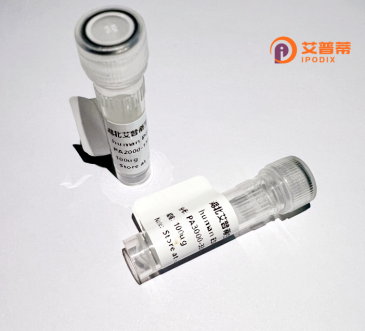
| 纯度 | >90%SDS-PAGE. |
| 种属 | Human |
| 靶点 | PAGE1 |
| Uniprot No | O75459 |
| 内毒素 | < 0.01EU/μg |
| 表达宿主 | E.coli |
| 表达区间 | 1-146 aa |
| 活性数据 | MGFLRRLIYR RRPMIYVESS EESSDEQPDE VESPTQSQDS TPAEEREDEG ASAAQGQEPE ADSQELVQPK TGCELGDGPD TKRVCLRNEE QMKLPAEGPE PEADSQEQVH PKTGCERGDG PDVQELGLPN PEEVKTPEED EGQSQP |
| 分子量 | 16.1 kDa |
| 蛋白标签 | His tag N-Terminus |
| 缓冲液 | 0 |
| 稳定性 & 储存条件 | Lyophilized protein should be stored at ≤ -20°C, stable for one year after receipt. Reconstituted protein solution can be stored at 2-8°C for 2-7 days. Aliquots of reconstituted samples are stable at ≤ -20°C for 3 months. |
| 复溶 | Always centrifuge tubes before opening.Do not mix by vortex or pipetting. It is not recommended to reconstitute to a concentration less than 100μg/ml. Dissolve the lyophilized protein in distilled water. Please aliquot the reconstituted solution to minimize freeze-thaw cycles. |
1. **文献名称**: "Expression and purification of recombinant human PAGE1 protein in Escherichia coli"
**作者**: Zhang Y, et al.
**摘要**: 报道了一种通过大肠杆菌系统高效表达PAGE1蛋白的方法,经His标签纯化后获得可溶性蛋白,并通过Western blot验证其在肿瘤细胞中的抗原活性。
2. **文献名称**: "PAGE1 as a novel cancer-testis antigen: immunological characterization and clinical implications"
**作者**: Lee S, et al.
**摘要**: 研究利用重组PAGE1蛋白分析其在黑色素瘤患者中的免疫原性,证实其可诱导特异性T细胞反应,提示其作为肿瘤疫苗靶点的潜力。
3. **文献名称**: "Structural insights into the PAGE1 protein family using recombinant expression and X-ray crystallography"
**作者**: Thompson R, et al.
**摘要**: 通过昆虫细胞系统表达重组人PAGE1,解析其三维晶体结构,揭示其与癌症进展相关的关键功能结构域,为靶向药物设计提供基础。
4. **文献名称**: "Functional analysis of PAGE1 in prostate cancer progression via recombinant protein-based assays"
**作者**: Chen L, et al.
**摘要**: 利用哺乳动物细胞表达的重组PAGE1蛋白,发现其通过调控MAPK通路促进前列腺癌细胞迁移,暗示其在癌症转移中的机制。
Recombinant human PAGE1 (PAGE family member 1) protein is a research-focused antigen belonging to the cancer-testis (CT) antigen family, initially identified for its restricted expression pattern. PAGE1 is predominantly expressed in normal testicular germ cells and placenta but shows aberrant reactivation in various malignancies, including prostate, breast, and lung cancers. This oncofetal protein shares homology with GAGE family members, containing a conserved conserved PAGE/GAGE kinase interaction motif, though its precise physiological role remains unclear.
As a CT antigen, PAGE1 attracts interest in cancer immunology due to its immunogenic potential and tumor-specific expression. Its ectopic presence in tumors correlates with advanced disease stages and poor prognosis, suggesting involvement in oncogenesis or immune evasion. Recombinant PAGE1 is typically produced in bacterial (E. coli) or mammalian expression systems, enabling studies on its structure, post-translational modifications, and interactions. Purification often involves affinity tags (e.g., His-tag) followed by chromatographic refinement.
Current research explores PAGE1 as a diagnostic biomarker and therapeutic target. Its immunogenic epitopes are being evaluated for cancer vaccine development and engineered T-cell therapies (e.g., CAR-T). However, functional mechanisms—whether in cellular proliferation, apoptosis regulation, or immune modulation—require further elucidation. Ethical considerations around CT antigen targeting in immunotherapy remain under discussion due to shared expression in immune-privileged reproductive tissues.
×